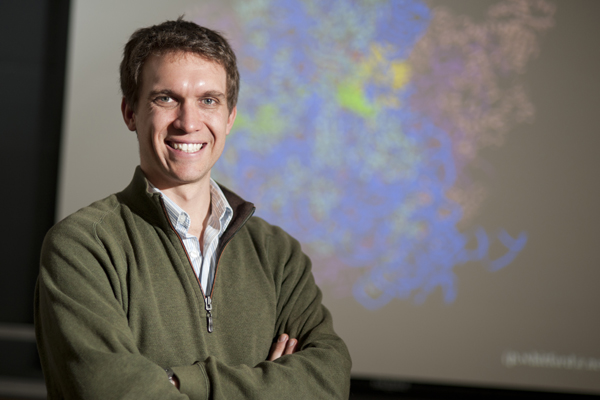Under the hood of the ribosome

We all know—generally speaking—how a car works: The gas pedal makes it go, the break pedal makes it stop, and the steering wheel determines its course. But pop open the hood and you’ll find there’s a lot more nuance to those maneuvers.
With macroscopic machines, getting under the hood is a straightforward process, but when it comes to the molecular machines driving biological functions inside our cells, things get a lot more complicated, according to Paul Whitford, an assistant professor of physics.
That’s because the environment in which they operate has a much greater impact on the machines themselves. For example, water molecules are constantly bombarding them, and since the energy of a water molecule is very close to that of the molecular bonds in these microscopic machines, the impact is significant.
Whitford equates it to a car that moves from the force of wind alone. “Imagine you have to wait for random gusts of wind to push you over a mountain. That would be a very inefficient way of driving, but that’s how microscopic machines work,” he said. “The question we are asking is: What are the properties of those random kicks that guide the machine’s movement?”

A computerized depiction of the e. coli ribosome. The small spheres represent charged particles in the surrounding environment. Image by Paul Whitford.
In a paper recently published in the journal PLoS Computational Biology, Whitford and collaborators from Cornell Medical School, University of California, Berkeley, and Los Alamos National Laboratory present a computational framework that estimates those random kicks for the molecular machine known as the ribosome. Via a process called translocation, ribosomes make proteins from the instructions given in RNA. Without them, life would not be possible, Whitford said. But we have very little idea of the physical principles that guide their function, that is, we don’t know what’s going on under the hood.
Ribosomes consist of hundreds of thousands of atoms arranged in a very complex structure, which was only determined in the early 2000s after several decades of study. With that structure in hand, along with advanced computational techniques, and an understanding of the processes that occur around the ribosome, researchers are now able to study the specific atomic interactions within the enormous structure. According to Whitford, they can use this information to estimate how the ribosome will change its conformation over time.
Whitford’s team obtained a simulation of the ribosome in action for more than 1.3 microseconds—roughly five times longer than the lab’s previous record-breaking simulation. The calculation took several months and required the use of two supercomputers—the NMCAC Encanto Supercomputer in New Mexico and the TACC Lonestar Supercomputer in Texas.
The computational framework presented in this research will be a useful tool for experimental biologists studying the ribosome, Whitford said. Having this ground-level understanding of the machine, experimental data about the kinetics and energetics of ribosomal processes can now be compared in a meaningful way, essentially allowing experimentalists to connect the gas pedal’s function to the engine.





